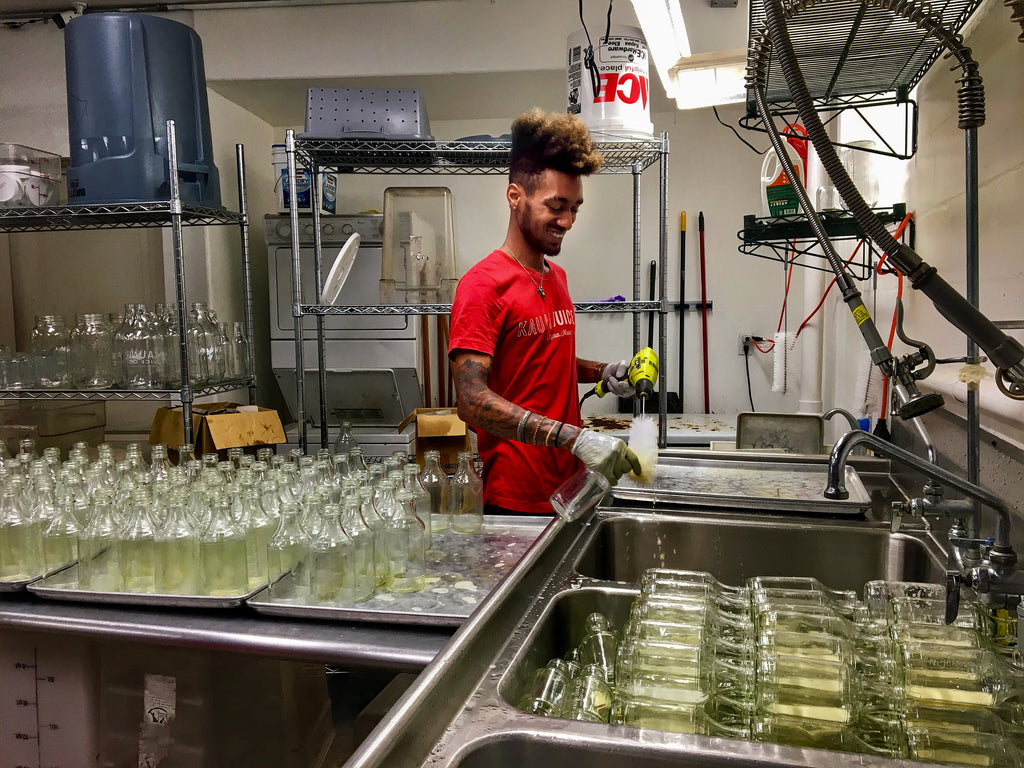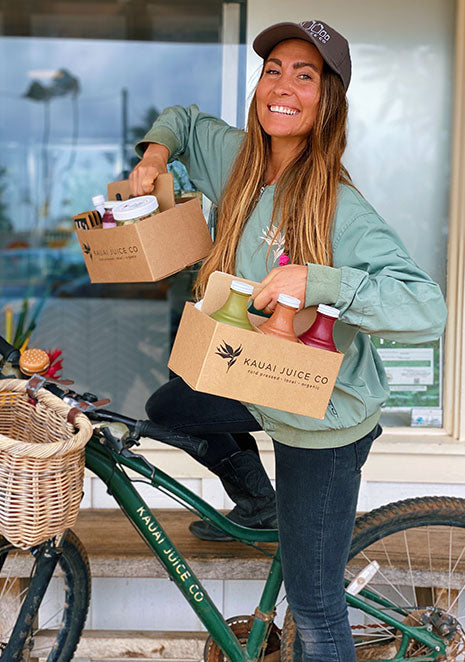
It’s 8 a.m. on a Tuesday and Juice Hines, power drill in hand, has assumed position at the commercial sink inside Kauai Juice Company’s Kapaa production facility. Of course, his task for the next three hours has nothing to do with drilling.
Affixed to the end of the appliance held in Hines’ balled-up fist is a bottle brush with a thousand bristles. At the push of the power switch, Hines’ left arm morphs into the cleverest little germ, juice and nut milk-scouring bottle scrubber on this side of the Pacific.
“I’m paying attention for things like cracks in the lip of the bottle,” says Hines, who is 21. “I get into a nice rhythm with it.”
Behind the scenes, this is how every day at Kauai Juice Co. begins: Counting, sorting, cleaning, sanitizing and rinsing hundreds and hundreds of glass bottles — an average of about 800 bottles per day.
These are the bottles the company buys back from customers who meet the bottle redemption program’s single requirement: Your bottle must be rinsed clean of juice, kombucha or nut milk, and the glass lip must be free of chips and cracks. In return, Kauai Juice Co. pays out fifty cents in store credit, or ten cents in cash, for every returned 17-ounce glass bottle. It’s all part of the company’s stand against single-use plastics.
“When I first started working here, it didn’t make sense to me because I’m a numbers guy and we are losing so much money on this project,” explains Production Manager Zach Quisenberry, who supervises the bottle reuse program. “That didn’t matter to (Kauai Juice Co. owner) Kristal. The way she sees it, this is a small island, the landfill is overstuffed as it is, and we weren’t going to be contributors to that. Reusing the bottles is really important to her and I’ve come to see how important it is to the sustainability of our island community.”
Talking as he tours an assembly line of ready-to-sanitize bottles, Quisenberry jolts.
“This bottle right here is at least two years old,” he excitedly proclaims.
He holds the bottle up over his head with pride.
“I know how old it is because it’s been that long since we bought bottles with this thinner, less durable lip,” Quisenberry explains. “I bet you this bottle has been reused six times!”
In 2016, Kauai Juice Co. partnered with its customers to prevent 242,816 bottles from littering Kauai’s landfill, which absorbs 81,000 tons of annual waste and is on pace to reach maximum capacity by 2026.
In 2017, the company is on pace to clean, sanitize and repurpose 335,813 bottles.
And on this particular June day, Hines will sanitize 676 bottles with his machine-powered, iodophor-soaked bottle brush. Another 20 bottles will be banished to the recycling bin due to a chip in the glass or because they are too dirty to clean efficiently.
While recycling waste is admirable, Kauai’s recyclables are shipped to some pretty far-flung places, which means it’s not always an environmentally viable means of getting rid of things. Metals, white paper and some clear plastics go to China. Other materials go to the U.S. Mainland. Each of these thousand and odd mile hauls comes at an environmental cost.
Kauai Juice Co.’s bottle redemption program seeks to provide a better, more sustainable option.
The company is strict, however, on its golden rule: If you want your bottle redemption payout, you must return a bottle that has been rinsed clean.
A quick rinse in the kitchen faucet will usually suffice, although a nut milk bottle that has been left to sit in a hot car for several days may need a little elbow grease. To help you succeed at the task, the company’s three retail locations sell a $3 bottle brush that’s guaranteed to rid your bottle of sticky kombucha or stubborn nut milk in no time.
Manager Jackie Grant says the company is constantly working to improve all of its systems. The goal, she says, is to influence other companies to make sustainable business a priority--showing by example that doing the right thing for the environment is not only worth it, but achievable and manageable in the long run.
“It’s rewarding to be involved with any part of the sustainability movement,” Grant says. “Whether it’s a small part, like personally reusing a bottle our opting out of single-use plastic, or playing a larger role--like designing a company based on a principle that isn’t the easiest or the most profitable, but represents what’s best for the community at large.”
written by Brittney Lyte


Leave a comment